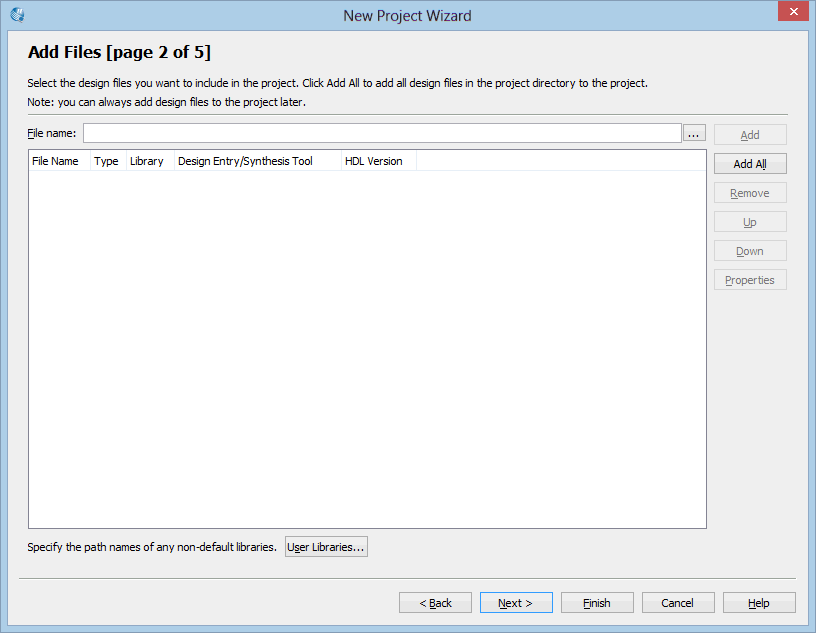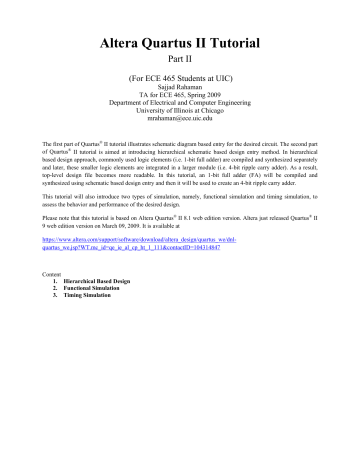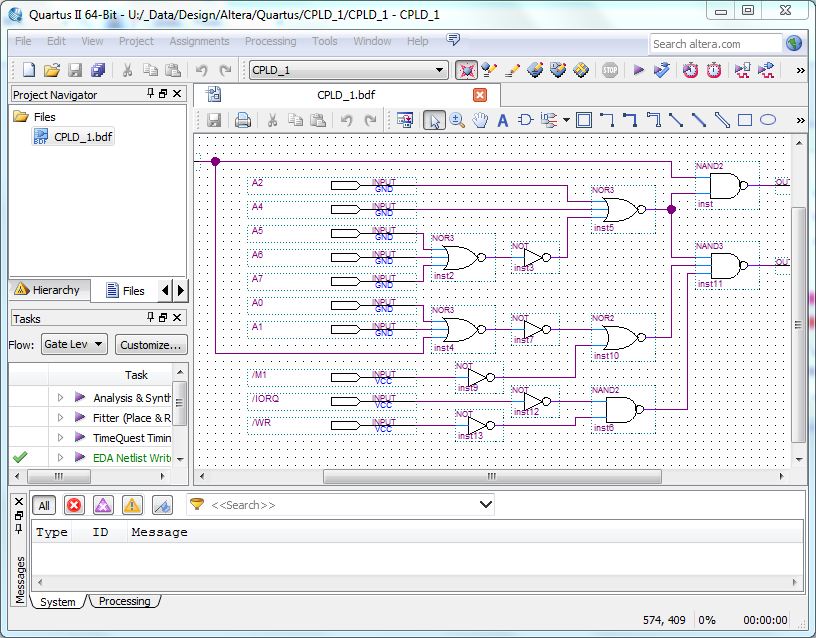
- #ALTERA QUARTUS II TUTORIAL HOW TO#
- #ALTERA QUARTUS II TUTORIAL INSTALL#
- #ALTERA QUARTUS II TUTORIAL SOFTWARE#
- #ALTERA QUARTUS II TUTORIAL SIMULATOR#
That is why edited permission for the usb_device is necessary.Ĭreate a file /etc/udev/rules.d/51-usbblaster.
#ALTERA QUARTUS II TUTORIAL HOW TO#
You'll usually run these as a user, which means jtagd will also run as a user. Design: 74163 Quartus II Tutorial Prepared By: Lawrence Fan, Joe Ebel Introduction: The purpose of this tutorial is to demonstrate how to use the 74163 4-bit counter in Quartus II simulations.
#ALTERA QUARTUS II TUTORIAL SOFTWARE#
If not already running, jtagd will be startetd automatically when the Quartus software or jtagconfig is run. Jtagd, part of the Quartus tools, is a deamon that provides the interface between the Altera tool accessing the JTAG chain and the USB driver. By default, only root has access to these so we must make sure the user is allowed to access them as well. The Quartus software will use the Linux built-in usb_device drivers. Take note of the Product ID listed - 6010 in the above example. usb 2-2: New USB device strings: Mfr=1, Product=2, SerialNumber=3 usb 2-2: New USB device found, idVendor=09fb, idProduct=6010 4) USB-Blaster configuration This part is based on a blog post from fpga-dev.Īt first, connect the cable and make sure the USB device is recognized:
#ALTERA QUARTUS II TUTORIAL INSTALL#
$SOPC_KIT_NIOS2/bin/eclipse-nios2 -configuration $HOME/.nios2-ide-6.1 $WORKSPACE_ARGS packages I needed to get on a MX Linux install included gcc-multilib, lib32ncurses5, libx11-6, libfreetype6, libpng12, libc6, libxtst6, zlib1g, libssl1.0.0 and libssl-dev generally the :i386 versions. It may also require starting it through the terminal with: The eclipse-nios2 tool requires installing libgtk2.0-0:i386 It gives a general overview of a typical CAD ow for designing circuits that are implemented by using FPGA devices, and shows how this ow is realized in the Quartus II software. Look up on what package you may find this library and install it. Quartus II Introduction Using Verilog Designs For Quartus II 13.1 1Introduction This tutorial presents an introduction to the Quartus® II CAD system. If it doesn't work, run it from the terminal and there should be some complaint about a missing packge or library. Quartus II Introduction Using VHDL Design This tutorial presents an introduction to the Quartus R II CAD system. Try opening and using any tool directly fom the Quartus GUI. Sim’s robust debugging environment to track down the cause of the problem.Export QUARTUS_64BIT=1 # Remove this if running on 32 bitĮxport ALTERA_ROOT="$HOME/Applications/altera" # Change this to the path you've installed Altera Quartus atĮxport QUARTUS_ROOTDIR_OVERRIDE="$ALTERA_ROOT/quartus"Įxport QSYS_ROOTDIR="$QUARTUS_ROOTDIR_OVERRIDE/sopc_builder/bin"Įxport QUARTUS_LIBRARY_PATHS="$QUARTUS_ROOTDIR_OVERRIDE/linux/:/lib/x86_64-linux-gnu/"Įxport SOPC_KIT_NIOS2="$ALTERA_ROOT/nios2eds"Įxport LD_LIBRARY_PATH="$LD_LIBRARY_PATH:$QUARTUS_LIBRARY_PATHS"Įxport PATH="$PATH:$ALTERA_ROOT/quartus/bin"Ī few 32-bit packages will probably need to be installed on 64-bit systems in order for some tools to work. Debugging Your Results: If you don’t get the results you expect, you can use Model. Assuming the design loads successfully, the simulation time is set to zero, and you enter a run command to begin simulation. MORE THAN A TUTORIAL - A DEMO QUARTUS II / MODELSIM MODELSIM ECE232 Altera/Modelsim Tutorial Design an 8 bit CLA Adder Delay computation for Pi and Gi.




#ALTERA QUARTUS II TUTORIAL SIMULATOR#
Loading the Simulator with Your Design and Running the Simulation: With the design compiled, you load the simulator with your design by invoking the simulator on a top-level module (Verilog) or a configuration or entity/architecture pair (VHDL). You can simulate your design on any platform without having to recompile your design. Sim library format is compatible across all supported platforms. Tutorial of ALTERA Cyclone II FPGA Starter Board This is a simple project which makes the LED and seven-segment display count from 0 to 9. These topics include creating symbols for use in a hierarchical design, using Altera parameterized modules, such as a ROM, and initializing ROM contents. Compiling Your Design: After creating the working library, you compile your design units into it. ADVANCED QUARTUS II TUTORIAL OVERVIEW This tutorial illustrates several advanced topics that were not covered in Lab 2. In the same manner and in the same library that you found the input pins, add an output pin from the Symbol library. Sim by creating a working library called "work, " which is the default library name used by the compiler as the default destination for compiled design units. Quartus Tutorial with Basic Graphical Gate Entry and Simulation (Last verified for Quartus Prime Lite Edition 17.1) 3. You typically start a new simulation in Model. Sim, all designs are compiled into a library. 5 e Creating the Working Library: In Model.


 0 kommentar(er)
0 kommentar(er)
